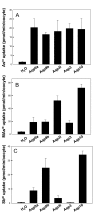Arsenic transport by zebrafish aquaglyceroporins
- PMID: 19939263
- PMCID: PMC2788550
- DOI: 10.1186/1471-2199-10-104
Arsenic transport by zebrafish aquaglyceroporins
Abstract
Background: Arsenic is one of the most ubiquitous toxins and endangers the health of tens of millions of humans worldwide. It is a mainly a water-borne contaminant. Inorganic trivalent arsenic (AsIII) is one of the major species that exists environmentally. The transport of AsIII has been studied in microbes, plants and mammals. Members of the aquaglyceroporin family have been shown to actively conduct AsIII and its organic metabolite, monomethylarsenite (MAsIII). However, the transport of AsIII and MAsIII in in any fish species has not been characterized.
Results: In this study, five members of the aquaglyceroporin family from zebrafish (Danio rerio) were cloned, and their ability to transport water, glycerol, and trivalent arsenicals (AsIII and MAsIII) and antimonite (SbIII) was investigated. Genes for at least seven aquaglyceroporins have been annotated in the zebrafish genome project. Here, five genes which are close homologues to human AQP3, AQP9 and AQP10 were cloned from a zebrafish cDNA preparation. These genes were named aqp3, aqp3l, aqp9a, aqp9b and aqp10 according to their similarities to the corresponding human AQPs. Expression of aqp9a, aqp9b, aqp3, aqp3l and aqp10 in multiple zebrafish organs were examined by RT-PCR. Our results demonstrated that these aquaglyceroporins exhibited different tissue expression. They are all detected in more than one tissue. The ability of these five aquaglyceroporins to transport water, glycerol and the metalloids arsenic and antimony was examined following expression in oocytes from Xenopus leavis. Each of these channels showed substantial glycerol transport at equivalent rates. These aquaglyceroporins also facilitate uptake of inorganic AsIII, MAsIII and SbIII. Arsenic accumulation in fish larvae and in different tissues from adult zebrafish was studied following short-term arsenic exposure. The results showed that liver is the major organ of arsenic accumulation; other tissues such as gill, eye, heart, intestine muscle and skin also exhibited significant ability to accumulate arsenic. The zebrafish larvae also accumulate considerable amounts of arsenic.
Conclusion: This is the first molecular identification of fish arsenite transport systems and we propose that the extensive expression of the fish aquaglyceroporins and their ability to transport metalloids suggests that aquaglyceroporins are the major pathways for arsenic accumulation in a variety of zebrafish tissues. Uptake is one important step of arsenic metabolism. Our results will contribute to a new understanding of aquatic arsenic metabolism and will support the use of zebrafish as a new model system to study arsenic associated human diseases.
Figures






Similar articles
-
Uptake and translocation of arsenite by Pteris vittata L.: effects of glycerol, antimonite and silver.Environ Pollut. 2011 Dec;159(12):3490-5. doi: 10.1016/j.envpol.2011.08.027. Epub 2011 Sep 3. Environ Pollut. 2011. PMID: 21893373
-
Uptake of antimonite and antimonate by arsenic hyperaccumulator Pteris vittata: Effects of chemical analogs and transporter inhibitor.Environ Pollut. 2015 Nov;206:49-55. doi: 10.1016/j.envpol.2015.06.029. Epub 2015 Jul 2. Environ Pollut. 2015. PMID: 26142750
-
Aquaglyceroporins: generalized metalloid channels.Biochim Biophys Acta. 2014 May;1840(5):1583-91. doi: 10.1016/j.bbagen.2013.11.021. Epub 2013 Nov 27. Biochim Biophys Acta. 2014. PMID: 24291688 Free PMC article. Review.
-
Aquaglyceroporins and metalloid transport: implications in human diseases.Handb Exp Pharmacol. 2009;(190):309-25. doi: 10.1007/978-3-540-79885-9_16. Handb Exp Pharmacol. 2009. PMID: 19096785 Free PMC article. Review.
-
Aquaglyceroporins and orthodox aquaporins in human adipocytes.Biochim Biophys Acta Biomembr. 2022 Feb 1;1864(1):183795. doi: 10.1016/j.bbamem.2021.183795. Epub 2021 Oct 8. Biochim Biophys Acta Biomembr. 2022. PMID: 34627746
Cited by
-
Comparative Analysis of the aquaporin Gene Family in 12 Fish Species.Animals (Basel). 2019 May 13;9(5):233. doi: 10.3390/ani9050233. Animals (Basel). 2019. PMID: 31086002 Free PMC article.
-
The lineage-specific evolution of aquaporin gene clusters facilitated tetrapod terrestrial adaptation.PLoS One. 2014 Nov 26;9(11):e113686. doi: 10.1371/journal.pone.0113686. eCollection 2014. PLoS One. 2014. PMID: 25426855 Free PMC article.
-
Developmental age strengthens barriers to ethanol accumulation in zebrafish.Alcohol. 2014 Sep;48(6):595-602. doi: 10.1016/j.alcohol.2014.06.003. Epub 2014 Jun 8. Alcohol. 2014. PMID: 25012627 Free PMC article.
-
Arsenic Metabolism, Toxicity and Accumulation in the White Button Mushroom Agaricus bisporus.Toxics. 2022 Sep 22;10(10):554. doi: 10.3390/toxics10100554. Toxics. 2022. PMID: 36287835 Free PMC article.
-
Type II Na+-phosphate Cotransporters and Phosphate Balance in Teleost Fish.Pflugers Arch. 2019 Jan;471(1):193-212. doi: 10.1007/s00424-018-2239-4. Epub 2018 Dec 12. Pflugers Arch. 2019. PMID: 30542786 Review.
References
Publication types
MeSH terms
Substances
Grants and funding
LinkOut - more resources
Full Text Sources
Medical
Molecular Biology Databases

